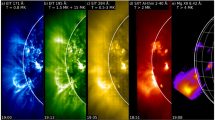Abstract
I find that a one-dimensional strong coronal shock (M s ⩾ 3) will grow outward until the Mach number (M s ) ceases to increase with height (dM s /dh = 0). The shock is driven by the pressure gradient and it is damped by gravity and by energy losses (radiative and conductive). The driving and damping terms reach equilibrium for M s ∼- 4.
Standard shock jump conditions for M s ∼- 4 lead to post-shock temperatures in the corona in the range 107 to 1.8 × 107K and emission measures from 3.8 × 1047 to 3.8 × 1048 cm-3. For isolated simple events, I predict an exponential decay of the emission measure with decay times in the range 1 ⩽ τ ⩽ 6.5 min.
In a detailed study of over 4000 X-ray bursts, Drake (1970) compares 1 to 6 keV X-ray data with 7.7 to 12.5 keV X-ray data (the ‘thermal’ component) and finds ranges for the temperatures of 1.2 × 107 to 1.8 × 107K, for the emission measures of 5.1 × 1047 to 3.8 x 1048 cm-3 and for the decay times 0.5 ⩽ τ ⩽ 20 min. He also finds that the emission measure varies “... both from event to event and within the event, by more than a factor of two”.
The agreement between the predictions and the observations makes it appear that a strong shock in the corona will produce a post-shock state that yields the observed characteristics of the soft component of X-ray bursts (the ‘thermal’ X-rays).
I give several examples where sprays and fast eruptive prominences \(\left( {M\tilde > 1} \right)\), that are not associated with solar flares, are associated with ‘thermal’ X-ray bursts. There were two slow eruptive prominences (M ≪ 1) in the sample, and neither of them yielded a detectable X-ray burst.
Similar content being viewed by others
References
Acton, L. W.: 1968, Astrophys. J. 152, 305.
Anderson, G. F.: 1966, Dissertation, University of Colorado, Boulder, Colorado.
Billings, D. E.: 1966, in A Guide to the Solar Corona, Academic Press, New York, N.Y.
Bird, G. A.: 1964, Astrophys. J. 139, 675 and 684.
Drake, J. F.: 1970, Dissertation, University of Iowa.
Frost, K. J.: 1969, Astrophys. J. 158, L159.
Hyder, C. L. and Lites, B. W.: 1970, Solar Phys. 14, 147.
Hyder, C. L., Dunn, R. B., Evans, J. W., and Gilliam, L. B.: 1970, submitted to Solar Phys.
Kane, S. R.: 1969, Astrophys. J. 157, L139.
Kopp, R. A.: 1968, Dissertation, Harvard University, AFCRL-68-0312.
Kundu, M. R.: 1965, in Solar Radio Astronomy, Interscience Publ., New York, N.Y., p. 343.
Moreton, G. E.: 1960, Astron. J. 65, 494.
Parker, E. N.: 1963, Interplanetary Dynamical Processes, Interscience Publ., New York, N.Y.
Ramsey, H., Smith, S. F., and Angle, K.: 1968, Lockheed Missiles and Space Co., Report LMSC-681495.
Schatzman, E.: 1949, Ann. Astrophys. 12, 203.
Schwarzschild, M.: 1948, Astrophys. J. 107, 1.
Smith, E. V. P.: 1968, in Mass Motions in Solar Flares (ed. by Y. Öhman), John Wiley and Sons, Inc., New York, N.Y., p. 137.
Smith, S. F. and Angle, K.: 1969, Lockheed Missiles and Space Co., Report LMSC-687340.
Teske, R. G.: 1969, Solar Phys. 6, 193.
Uchida, Y.: 1960, Publ. Astron. Soc. Japan 12, 376.
Author information
Authors and Affiliations
Additional information
Now at the Dept. of Physics and Astronomy (NASA), Univ. of New Mexico; Albuquerque, N.M. 87106.
Rights and permissions
About this article
Cite this article
Hyder, C.L. Strong coronal shocks and ‘thermal’ solar X-ray bursts. Sol Phys 14, 196–203 (1970). https://doi.org/10.1007/BF00240178
Received:
Issue Date:
DOI: https://doi.org/10.1007/BF00240178




